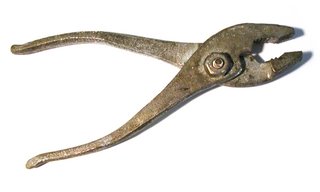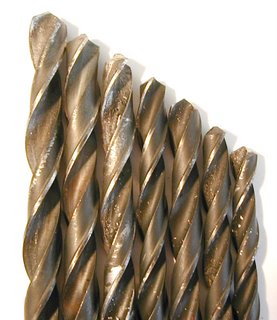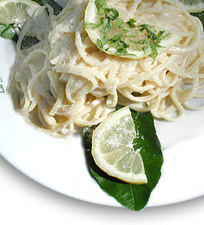 Phthalates vs Trimellitates
Phthalates vs Trimellitates
This is an issue I’ve been working on a lot recently. We know that when EU took a position against phthalates, in targeted children products, many polymer industries started to work more with alternatives and particularly "trimellitates".
The main seems to be:
TOTM (trioctyl)
TIOTM (trisooctyl)
TINTM (triisononyl)
I learned that "trimellitate plasticizers" are the alternative for phthalate plasticizers when high temperature applications and low volatility are the main issues. TOTM seems to have a unique low migration properties and extraction resistance properties.
I knew these materials are produced by the esterification of a range of alcohols with trimellitic anhydride (TMA), which is similar in structure to phthalic anhydride with the exception of a third functionality on the aromatic ring.
This is not new at all, but the possibility of using these to "by-pass" the EU directive in the children (and medical related items), seems to me something questionable. As far as environmental fate it seems the behavior is the same, as far as healthy issues for end Customers we miss enough data to say something, also this “less leakage” proprieties is still under more serious evaluation (I have evidence of this scrolling the EPA web-site). The cost for these plasticizers seems to be some 40% more expensive comparing to phthalates.
Do You know something more about this?
Here You find some good articles, describing the situation upward in the chain. Good picture, but missing some information about risk assessment of these substances environmentally and H6S related issues.
By:
Alexander H. TulloPhthalate esters, used to make polyvinyl chloride (PVC) flexible, face a handful of prohibitive regulations and a ton of bad publicity. Although controversy over phthalates has helped spur some substitution by other products—as well as replacement of PVC by other polymers—the cost-effective plasticizers are still entrenched in many regions.
Few chemicals on the market today have undergone as much scientific scrutiny as phthalate esters. And environmental and industry groups pitted against each other in the debate have no shortage of studies they can use as ammunition.
The environmental groups cite studies linking doses of some phthalates to reproductive problems in rodents and to damaged sexual development in neonatal infants. Industry groups counter that phthalates and adverse health effects in humans never have been indisputably connected.
The debate, and the years of bad press it has generated, is starting to yield modest regulatory restrictions. In Europe, starting in 2006, three phthalate esters—including di(2-ethylhexyl) phthalate (DEHP), the highest volume phthalate—will be permanently banned for use in toys, and another three—including diisononyl phthalate (DINP)—will be banned in toys that can be mouthed. The European Union has also banned some phthalates in cosmetics.
Japan has a ban in place for DINP and DEHP in toys as well as a ban on DEHP in food-handling gloves. California has proposed similar bans on phthalates in toys.
And beyond the regulations, there have been voluntary phaseouts. Health Care Without Harm, an activist group that campaigns against the use of phthalates and PVC in medical products, lists dozens of companies that make DEHP-free or PVC-free products, such as blood bags, feeding sets, and even body bags.
And plenty of non-phthalate plasticizers for PVC do exist. In a paper presented at the Plasticizers 2004 conference in Brussels, Arnold Tukker, program manager for sustainable innovation at the Dutch research organization TNO, listed trimellitates, aliphatic dibasic esters, phosphates, benzoates, citrate esters, polymeric plasticizers, sulfonic acid, chloroparaffins, and sorbitol as potential substitutes. But, he pointed out, “whereas phthalates are multipurpose plasticizers that find broad application, this is not always the case with the alternatives.” He now adds that, because alternatives are more expensive than phthalates, they will not be broadly tested unless bans on phthalates are imposed on industry.
As a result, phthalates remain the dominant class of plasticizers. According to the Houston-based consultancy
Chemical Market Resources Inc. (CMRI), they compose about 87% of the 10.4 billion-lb-per-year world market for plasticizers.
CMRI President Balaji B. Singh expects phthalates to continue to remain dominant. He sees more of a stalemate than a threat. For example, the use of DEHP in applications like medical devices and toys will continue to be controversial in developed countries, but it will remain an insignificant issue in developing countries.
Robert S. Brookman, vice president of business development at
Teknor Apex, explains how price is the biggest barrier to substitution. Teknor Apex says it is the third largest compounder of PVC in the U.S. And unlike the two larger firms, Georgia Gulf and PolyOne, its business is almost exclusively in flexible vinyl and largely in grades for medical applications. The company also makes some of its own phthalate, adipate, and trimellitate plasticizers.
“We've had people come to us asking for alternative compounds,” Brookman says. “We offer four to five different types. We send out a lot of samples of materials, and when we're asked to quote the price, no one ever orders any.”
He explains that DEHP, dominant in medical applications, is inexpensive compared with alternatives. Adipates, trimellitates, and citrates cost about 50%, 100%, and 140% more, respectively. Plasticizers can make up a third, by mass, of compounded PVC. Thus, an alternative can drive up the cost of a PVC compound from about 80 cents to about 95 cents per lb. “People like to do the right thing, or what they would consider to be the right thing from a green standpoint, but are not willing to pay for it,” Brookman says.
Dwight M. Lyman, global marketing manager for
ExxonMobil Chemical's global oxo chemical business, seconds Brookman on the issue of price. “The other plasticizers that are out there that are not phthalates, that are technically alternatives, in almost all cases cost more money,” he says.
Although ExxonMobil is one of the largest phthalate ester producers in the world, it also makes nonphthalate plasticizers such as adipates and trimellitates. Lyman says these tend to be used in applications where they are the optimal plasticizers because of their performance, not for environmental reasons. Adipates, for example, are used in shrink wrap; trimellitates are used in high-performance wire.
Nevertheless, chemical firms are hardly ignoring the controversy.
BASF, reacting to a 50% plummet in DEHP demand in Europe since 2000, is discontinuing production of DEHP and its raw material 2-ethylhexanol (2-EH) in Ludwigshafen, Germany. In Europe, the company is introducing Hexamoll Dinch plasticizer, a 1,2-cyclohexanedicarboxylic acid diisononyl ester “whose health safety is beyond all question,” it says.
Martha Brabston, BASF's business director for oxo alcohols and plasticizers in North America, says the new product is a response to pressures on molecules like DEHP. “It was launched by BASF in Europe to help customers comply with regulations in that region,” she says.
BASF says it has received a positive response in Europe, where the plasticizer is being used in toys and medical devices such as feeding tubes. The company has 25,000 metric tons of annual capacity for the product and says the potential market for such applications is 260,000 metric tons per year.
In the U.S., BASF is also making production adjustments, albeit not for regulatory reasons. It is converting a 2-EH plant in Pasadena, Texas, to make 2-propylheptanol (2-PH), which it will use as a feedstock for the new plasticizer dipropylheptyl phthalate (DPHP). But the company will continue to sell DEHP in North America.
Overall, ExxonMobil's Lyman says, growth in the phthalate ester market is nearly equal to the global growth in flexible PVC, which is about the same as global economic growth. He takes that as a sign that alternatives haven't made many inroads into the phthalates market.
But companies are still trying.
Eastman Chemical, for example, is marketing Eastman 168, a terephthalate plasticizer, according to Erin Bernhardt, the firm's manager of plasticizers and specialty materials. “It is a good fit for customers that are becoming more concerned about the controversial pressures,” she says. The product is being used in consumer goods, and Eastman is seeking other uses for it, such as food contact applications.
Another Eastman plasticizer, TXIB (2,2,4-trimethyl-1,3 pentanediol diisobutyrate), is not a phthalate, but Bernhardt says it is sold on its properties-its low viscosity makes it a natural plasticizer for PVC gloves-more than as an alternative to phthalate esters.
The private investment firm Arsenal Capital Partners last month purchased two companies that have nonphthalate plasticizers in their stable:
Reilly Industries, which offers citrate ester plasticizers, and
Velsicol, which makes benzoate plasticizers.
David Gleeson, president of Reilly's Morflex unit, says the company was selling citrate ester plasticizers long before phthalates were controversial. “We always presented them as an alternative material based on what citrates have to offer,” he says. They can be used at lower temperatures than phthalates, he notes, and less plasticizer is needed to do a similar job.
But Gleeson recalls that citrate esters started to be perceived as an alternative to phthalate esters in the late 1990s, as the issue began to get more attention. “Some of the major consumer product makers, specifically for toys, started to seek alternative products,” he says.
Though Gleeson concedes his products are more expensive per pound than phthalates, he says the extra cost translates into something like a 5-cent increase in the final cost of a typical finished article. Reilly is seeing 10% annual growth for citrate esters in applications such as toys, and about 7% growth overall, Gleeson says.
Richard A. Moras, director of business management for Velsicol, says his company's benzoate esters have been a substitute for phthalate esters since the 1970s in white glue. Since then, they have found use in vinyl applications such as flooring, wall covering, and gaskets.
Moras concedes there is no direct substitute for phthalate esters. “There is this heightened awareness, but the direct alternatives aren't out there,” he says. If there was one, he notes, it would undoubtedly be popular. “If you could flip a switch and the cost and performance were the same, converters would say, ‘Why wouldn't we do that?'”
Using other plasticizers isn't the only way to get rid of phthalates; another is using other polymers such as polyethylene.
Eastman's Bernhardt says a sign of weakness in flexible vinyl is that its growth rate is only a fraction of the growth rate of polyethylene. “The fact that flexible PVC is growing at only a 2% sort of rate tells me that we are seeing a decline and that people are looking at alternatives,” she says.
Despite the phthalate controversy, CMRI's Singh points out that the polymer has inherent advantages in many applications because it is versatile and cheap to make. “In a perfect world, PVC is not the best material,” he says. “But on a cost-benefit analysis, PVC is the poor man's plastic.”
As controversial as they sometimes are, phthalate esters are an inexpensive way to make a polymer more flexible. And, in fact, no one in the PVC industry expects phthalates to go away any time soon. Even those selling alternatives aren't so optimistic. “People think alternative products will take over the market, but that really is not the case,” Reilly's Gleeson says.
Additives are often-ignored components of plastics. In discussions of the market success of polyvinyl chloride or polypropylene, for instance, only the polymers are usually mentioned, and little credit is given to the chemistries that enable these products to be as useful as they are.
Sometimes there is good reason for this. Because certain types of additives haven't changed for decades, their growth often tracks the polymers that they are used with, and their presence is often forgotten. But in other cases, as when environmental and health concerns arise over their use, plastics additives take center stage until the industry finds a way either to replace the troublesome additives with newer varieties--often without government mandate--or, if possible, to prove its products are essentially harmless.
Plastics additives are big business for the specialty chemicals industry. According to Fred Gastrock, a consultant with
BRG Townsend , a Mount Olive, N.J.-based chemical consultancy, the global market for plastics additives was $15.5 billion in 1999, representing nearly 18 billion lb of material. Included in these figures are data for plasticizers, impact modifiers, heat stabilizers, lubricants, biocides, antioxidants, antiblocking agents, slip agents, light stabilizers, clarifying agents, flame retardants, organic peroxides, blowing agents, antistatic agents, and coupling agents. Excluded are colors and fillers.
Gastrock says the entire sector is growing by about 4 to 5% annually, with North American and European markets climbing 3% per year, and Asia and the rest of the world growing at 6 to 8%.
Plasticizers are by far the largest class of plastics additives. Global volumes of plasticizers, according to Gastrock, were about 10 billion lb in 1999 and were valued at about $5 billion. Growth in this mature market is a modest 2 to 3% per year.
However, recent years have brought controversy to the plasticizer marketplace. Chemical and plastics industry organizations have lined up against environmental groups over plasticizers used in flexible PVC, such as diethylhexyl phthalate (DEHP) and diisononyl phthalate (DINP), because of potentially adverse effects on the human reproductive system. Because of the attention, some manufacturers have moved away from using vinyl-based products in toys that babies suck on, and others have introduced alternatives to vinyl-based medical devices.
Gastrock says losing the toy applications has had little impact on the phthalate plasticizer and PVC markets because less than 1% of phthalate plasticizers are used in toys. A ban on phthalate plasticizers in medical products would be more serious, he says, because that represents about 10% of the phthalate plasticizer market.
D. Lane Wisner, director of environmental solutions at plastics compounder PolyOne, says phthalates in vinyl medical products like IV bags and medical tubing have raised little concern until recently. "The use of phthalates in vinyl medical products has been around for 30 years," he points out. "The fact that the
Food & Drug Administration has chosen not to take a position against them in all these years is a tremendous validation in and of itself."
Another strength of phthalate plasticizers, Gastrock says, is that they are hard to replace. "There are aliphatics, trimellitates, phosphorous materials, citrates, epoxies, and polymeric types, and they all have their little niches, but none of them has been able to take over or find broad use in most phthalate markets," he explains.
Flame retardants
Halogenated flame retardants are also coming under fire. Plastics containing certain brominated flame retardants are believed to release polybrominated dibenzo-p-dioxins and polybrominated dibenzofurans when incinerated. The fear is that workers in recycling and processing plants can be exposed to dangerous levels of the chemicals.
While there have been no bans, the
World Health Organization has recommended against the use of brominated flame retardants when substitutes can be found. In addition, manufacturers of end-use products that do not use brominated flame retardants and other halogenated compounds are rewarded through qualification for various voluntary environmental labeling programs in Europe.
According to Gastrock, the global market for all varieties of flame retardants is $2.2 billion, with volumes at around 2.2 billion lb. But Gastrock points out that, despite the hullabaloo, brominated flame retardants are still growing by 5% per year.
Nonetheless, European governments have been closely scrutinizing brominated flame retardants; in particular, those based on diphenyl oxide, says John Nicols,
Albemarle's global business director of flame retardants. "Over the last year and a half, there has been a fair amount of toxicological work," he says, noting that this could be good for the industry, if, as he believes, some classes of brominated flame retardants are given a clean bill of health and a consensus on their use is reached.
Although Europeans are keeping an eye on brominated flame retardants, they are becoming increasingly concerned with fire safety, says William Neagle, flame retardants business director of
Great Lakes Chemical , a major producer of brominated flame retardants. "Debate over the use of flame retardants is surging back in favor of brominated flame retardants," he says.
Moreover, flame retardants are used because regulations put them in plastics in the first place, Gastrock notes. "No one is going to ban the things because you have a danger from something called fire," he says.
Neagle says European regulators are considering requiring more flame retardants in televisions and other products and that some furniture makers are voluntarily adding flame retardants to polyurethane cushioning for household use. The growing popularity of products containing flame retardants has boosted demand for flame retardants of all kinds, Albemarle's Nicols says. "The boom in electronic equipment has helped flame retardants broadly," he adds.
In addition, flame retardants have benefited from requirements in the U.K. and in California, among other states, mandating them in polyurethane cushioning for institutional furniture. Though this has increased demand for brominated flame retardants, it has also led to growing use of melamine crystal flame retardants.
Neagle admits, however, that despite high growth, brominated flame retardants are losing market share. "If you can have a non-halogenated flame retardant that gives you the same performance, then customers will use it," he says. Brominated flame retardants are also losing ground because of the growing use of polycarbonate/acrylonitrile-butadiene-styrene blends--which can use either halogenated or phosphate ester flame retardants--over ABS, in which brominated flame retardants are used.
But it might be hard to find alternatives to brominated flame retardants in other applications, Gastrock says. "A lot of people are trying to make phosphorus work," he says. "There are also melamine and ATH [alumina trihydrate] materials. None of these is the answer; they all have problems one way or another. In ATH, for example, you have to put 50% loading in the plastic for it to work in some applications. This would have negative effects on the plastic's performance properties," he points out.
Some brominated flame-retardant makers are diversifying their portfolios to play it safe. Last year, Great Lakes purchased for $162 million
FMC's process additives business, which, among other products, makes phosphate ester flame retardants and flame-retardant fluids. "We are not hedging our bets," Neagle says. "Great Lakes has realized that there's some shift in the market." In another move to strengthen its flame-retardant business, the company is consolidating all of its global manufacturing of antimony trioxide to Reynosa, Mexico.
Albemarle has also been developing nonbrominated flame retardants. The company formed an alliance with Borax Polymer Additives Group to develop zinc borate flame retardants and synergists. Albemarle will market the boron zinc flame retardants in Asia and will also sell any new flame retardants the collaboration develops. In addition, Albemarle has introduced its own line of phosphorus-based flame retardants, initially aimed at polycarbonate/ABS blends and other engineering polymer systems.
But Albemarle is also continuing to invest heavily in its bromine chemistry. It has established Jordan Bromine Co. with two partners in the Middle East. The partnership will establish a bromine and bromine derivatives plant, including a 50,000-metric-ton tetrabromobisphenol A plant in Safi, Jordan, in mid-2002.
Heat stabilizers
As with flame retardants and plasticizers, there are environmental issues for heat stabilizers, and, because of these issues, different additives are favored around the world.
The global heat stabilizer market is valued at about $1.8 billion, representing volumes of between 1.1 billion and 1.2 billion lb, according to Gastrock. The growth of heat stabilizers, at 4% per year, tracks the PVC market. Almost all heat stabilizers are used in either rigid or flexible PVC. The main kinds of heat stabilizers are organotins; lead; mixed metals such as barium/cadmium, barium/zinc, and calcium/zinc; and organic materials that companies are beginning to introduce.
In North America, lead is only found in wire and cable applications. Instead of lead, organotins are dominant in North America in rigid PVC applications, such as pipe. On the other hand, lead is used in all sorts of rigid applications in Europe, and some plastics converters and governments are phasing it out. Asian markets are somewhere in between North America and Europe in the predominance of lead.
In mixed metals, Ca/Zn has a better image than Ba/Zn or Ba/Cd, but it doesn't perform as well in many applications. "Ca/Zn will probably do better in the market than the others down the road," Gastrock says, adding that global growth in Ca/Zn and organotins will be more than 4% in the long run, while growth in lead and other mixed-metal classes will remain flat or decline. In North America, on the basis of volume, tin and mixed metals each accounts for about 40% of the heat stabilizer market and lead accounts for less than 20%, according to Gastrock's figures. In Europe, lead accounts for nearly 70% of the market, while mixed metals represent about 20%, and organotins, a mere 10%.
Crompton Corp. , one of the largest players in heat stabilizers, exited cadmium- and lead-based heat stabilizers a decade ago, according to John Hamilton, market manager of vinyl additives for Crompton's Witco polymer additives group. The move was part of the company's push to convert these markets to Ba/Zn and Ca/Zn.
"A lot of the conversion took place several years ago, so today cadmium is pretty small," says Sally Lenhart,
Ferro Corp.'s worldwide business director for polymer additives. "It is only used today when there are no alternatives."
As they phase out lead, Europeans will probably skip organotins altogether and opt for Ca/Zn instead, says William Hrubik,
PolyOne's director of sourcing. "In Europe, all of the heavy metals have perception issues that are much greater than in the U.S. Rather than going to tin, they are trying to see if they can use Ca/Zn stabilizer technology in rigid applications," he adds.
Crompton's Hamilton agrees. "Throughout Europe, pipe is stabilized with lead, and they want to knock out heavy metals completely," he says. "In Europe, Ca/Zn is what they are going to. They look at organotin as an interim solution," he adds. Crompton has been developing a Ca/Zn replacement for lead in rigid applications for the European market and is currently working on getting approvals for drinking-water pipe and food contact uses.
Crompton is also working on a Ba/Zn stabilizer for wire and cable. Lead, Hamilton says, is difficult to replace in this market because it is perfect for the applications. Lead has been the only heat stabilizer good enough to allow electrical wiring to pass stringent standardization tests. "Lead is the best stabilizer you can possibly use," he says.
Ferro is working on the development of organic stabilizers, Lenhart says, noting that, in the long run, they could solve the lead problem in Europe. But it will take time for them to catch on, she admits. "Nobody is clamoring for organic stabilizers, but we have to be prepared," she adds.
Antioxidants
Antioxidants are used in every kind of plastic, but polyolefins account for about 60% of global demand. In all, antioxidants have a $1.3 billion market globally, and volumes of about 500 million lb, Gastrock says. Growth in the market is about 4%, tracking the entire polymers sector.
The major types of antioxidants are the primary antioxidants--butylated hydroxytoluenes (BHT) and other hindered phenols--and the secondary antioxidants--phosphites and thioesters. Primary and secondary antioxidants are used in combination, Gastrock says.
One of the greatest changes that has occurred in antioxidants during the past decade has been the effects of
Ciba Specialty Chemicals' Irganox 1010 and 1076 coming off patent. This led to a number of producers, such as Great Lakes as well as some in Asia, entering the market with clones. When this happened, prices for the popular hindered phenols plummeted. "They used to sell for $5.00 to $6.00 per pound, and now prices can be as low as $2.00 to $2.50," Gastrock says. "Ciba had a nice run," he adds, noting that the company still has about half of the market, with Great Lakes as its closest competitor.
Felix Meyer, head of Ciba's global polymer additives business, says prices are stabilizing, and the company has found ways, such as value-added blends with other antioxidants and plastics additives, to hold on to market share. He notes also that some competitors have gone out of business. "For some of these competitors, manufacturing the products wasn't attractive anymore," he adds.
Great Lakes took advantage of this trend. It bought a foothold in the antioxidants business through three acquisitions in the early and mid-1990s to broaden its portfolio beyond flame retardants. Through these purchases, Great Lakes obtained hindered phenol and phosphite antioxidants as well as light stabilizers.
These companies were also making Irganox clones and soon found themselves in over their heads. Prices for hindered phenols plummeted, and the producers needed to consolidate, says Henri Steinmetz, vice president and general manager of Great Lakes' polymer stabilizers business. "We thought it was a very good move to be able to consolidate rapidly--to be in the situation to very quickly become a strong number two to Ciba," he adds.
Steinmetz says a key focus for Great Lakes in antioxidants is to keep costs down by building large and efficient capacity to produce common grades of antioxidants. He says this is what the company has been able to do at its plants in the U.S., South Korea, and Europe. The company is planning on repeating this in a new construction project under way in Al Jubail, Saudi Arabia.
The plant, which will be a joint venture between Great Lakes and Al-Zamil Group, will produce antioxidants and blends and is expected to start up during the third quarter of 2001. Steinmetz says the joint venture will sell directly to the large number of olefins producers building capacity in the region. These resin makers will add the antioxidants straight to their general-purpose grades of resin before they export to Asia and Europe. "The Middle East will emerge as one of the prime polyolefin-producing areas of the world," he says. "We wanted to be one of the first ones building greenfield manufacturing in this area."
Light stabilizers
Light stabilizers are among the most expensive plastics additives. The global market of $530 million represents only about 60 million to 65 million lb of material, Gastrock says. With annual market demand climbing 6 to 7%, they are among the fastest growing plastics additives. This is mostly because they ride the coattails of polypropylene, perhaps the fastest growing commodity polymer.
"Ultraviolet stabilizers are somewhat in fashion," Great Lakes' Steinmetz says. "In automotive uses, there is a big push to have UV-stabilized polypropylene. And then there's garden furniture, where people are looking for longer life and UV protection," he says, noting that polypropylene fiber is also a big outlet for UV stabilizers.
"There has been growth for polypropylene in exterior applications because of the versatility of the polymer itself," Ciba's Meyer says. "From a cost perspective, polypropylene is ideal. If you enhance it by giving it stability and some other properties, this is an even more attractive polymer." Ciba is a major global producer of hindered amine light stabilizers and is expanding global capacity by about 30% in various projects, including a new unit for high-molecular-weight hindered amines in Puebla, Mexico, in 2002.
Robert Gray, global marketing director of Cytec's polymer additives business, says hindered amine light stabilizers are among the fastest growing light stabilizers, even though they are already well established.
Cytec is also rejuvenating an old product: chelated nickel phenolate. Around for decades, nickel retreated out of the light stabilizers marketplace because of the emergence of effective hindered amines. "Nickel has become a niche product in areas where hindered amines do not work as well," Gray says, adding that it is incorporated in agricultural films used with roses, for example. Ag films are used for mulching and to cover greenhouses, among other uses. "Roses are one of the most difficult areas to use ag film in because sulfur is burned to fumigate them. That has a dramatic effect on other light stabilizers," he explains.
As in antioxidants, expired patents are also an issue in the light stabilizer market, Gray says. And Cytec and Ciba both are feeling the effects. Cytec's most popular light stabilizer--Cyasorb UV 3346--a high-molecular-weight hindered amine used in rotomolded polyethylene, agricultural films, and other polyolefin products, has about a year left on its patent. "I think it is possible and likely that we will have competition with the products, and that is something we will have to deal with," he says.
Antistatic agents
The antistatic agent market is about $130 million and 60 million lb globally, according to Gastrock, with growth between 4 and 5% per year. The biggest change in the market, he says, is that permanent antistatic agents are growing faster than migratory antistatic agents. Permanent antistatic growth is being driven by strong sales of document-handling office equipment and electronic equipment.
But temporary antistatic agents are growing robustly, too, says Dave Doles, associate director of marketing for performance chemicals for
Lonza , a maker of fatty acid esters, which are temporary antistatics, for the plastics industry. They are growing at 6 to 7% per year because of their role as processing aids for polypropylene and PVC.
Crompton's Hamilton says the company is planning to expand its antistatic business because of the high growth for electronic equipment. Cytec, Gray says, is looking at its options for its antistatic additives business to enhance its portfolio. "These are a pretty small part of our product line," he says. "We are evaluating where we are, and are evaluating what our next step should be," he says. Among other options, the company is considering expanding its product line.
Antistatics are a small part of Lonza's business as well, and the company has no plans for major expansions in the segment. Instead, the company is focusing on its lubricant additives and is launching a product in polyethylene, a relatively new area for Lonza. "We haven't done a lot in polyethylene. We've focused on polypropylene and ABS," Doles says. Lonza claims the new product, Glycolube ML-2, when used in linear low-density blown film applications, can reduce the costs of melt fracture additives packages by 40%.
Blends
One plastics additives business that is taking off is blends, Great Lakes' Steinmetz says. Great Lakes and other additives suppliers are blending the products they make with a few they don't to give customers products in a single, easy-to-use package. Steinmetz says Great Lakes is packaging its antioxidants with antislips, antiblocks, acid scavengers, clarifiers, and other products. The advantages to customers are improved blending and lower capital costs. The business, he adds, is growing by 40 to 50% per year for Great Lakes. "We see a strong trend in the industry going to blends at the moment, rather than looking for new molecules," he adds.
But blends are not the focus for every company, says Cytec's Gray, who points out that most large customer of antioxidants are polymer suppliers. Cytec focuses more on UV stabilizers used by compounders and masterbatch suppliers that are in the business of formulating. For these customers, blends from additives makers do not accomplish much. "For us to provide light stabilizers and give them to customers in a package isn't a huge advantage for them because they are mixing multiple components together anyway," he says. "In fact, they can view it as a threat."
But PolyOne's Hrubik is not concerned by these developments. He says such products will be used by either the resin maker or the converter, with compounding companies keeping their niche in between. "There is no conflict or threat from various parties in the value chain," he says.
Lincoln Ying, general manager of plastics additives for
Atofina , points out that ensuring that different additives work together has, for years, been a major service for plastics additives companies to provide. For example, he calls Atofina's portfolio of acrylic impact modifiers, stabilizers, and lubricants a "three-legged stool" for PVC compounders, on which Atofina has taken years to perfect formulation chemistry. "In this industry, discrete chemistry does not sell," he says.
Almost all plastics additives makers agree. Moreover, they believe that with stiffening environmental and product requirements, clones being made for goods that have come off patent, and other changes in the industry, their best defense is being able to provide value-added chemistry to their clients.










